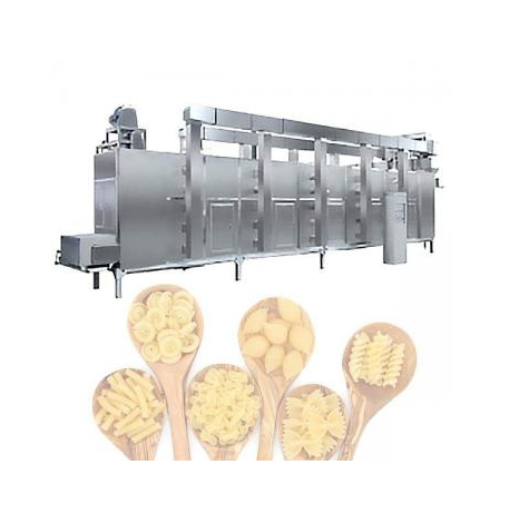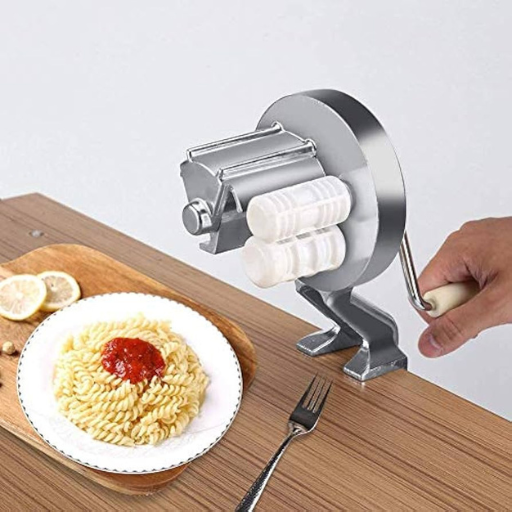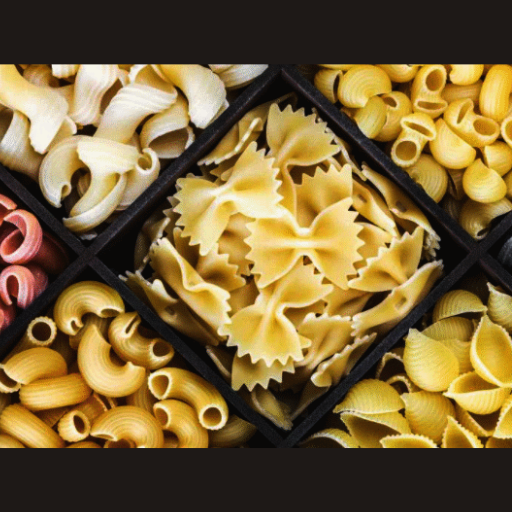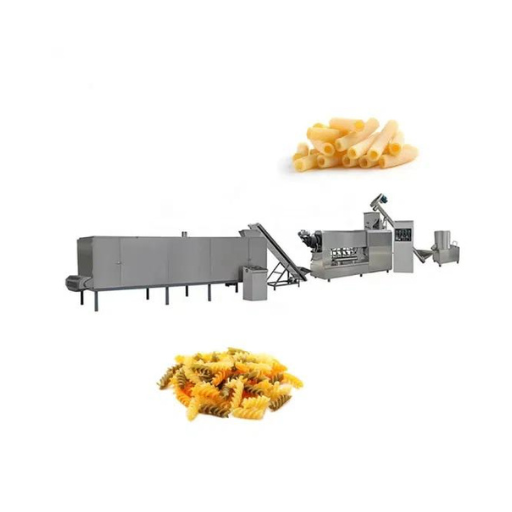If you’ve ever dreamt of making restaurant-quality pasta in the comfort of your own kitchen, you’re in the right place. This blog is dedicated to introducing you to the Ultimate Macaroni Pasta Machine, a transformative tool that brings the authentic taste of Italian cuisine right to your countertop. In the sections to follow, we’ll explore how this machine works, its key features, and the benefits of making pasta from scratch at home. Whether you’re a seasoned chef or a culinary novice, this guide will provide you with the insights and inspiration you need to elevate your pasta-making game. Stay tuned as we delve into tips, recipes, and the sheer joy of creating your own macaroni from start to finish.
What is a Macaroni Pasta Making Machine and How Does It Work?
Understanding Basic Components
Generally, a macaroni pasta making machine consists of several important parts: the mixing chamber, the extrusion die, the cutting mechanism and control settings. The flour, water and other ingredients are combined to form dough in the mixing chamber. Through pressure and force, its extrusion die transforms macaroni to be shaped from dough. After that, it is cut into separate macaroni pieces by the cutting mechanism which cuts it as it comes out of an extruder or dies in continuous form. Lastly, you can change speed of movement for dough amounting to pasta shapes at will using the control settings.
How Macaroni Pasta Maker Works
The macaroni pasta maker is able to turn simple ingredients into delicious pasta because all its components work together seamlessly. Here’s how this works step-by-step:
- Mixing: In mixing chamber, flour and water is put together to start with. For example, one hundred grams (100g) of flour mixed with forty five mls (45mls) of water would make a normal ratio but this could differ depending on the type of paste one wants to produce. This mixture is kneaded by the machine until a uniform dough forms.
- Extrusion: At this point when dough gets appropriate consistency its being forced through an extrusion die by applying some pressure. Stainless steel extrusion dies mold the dough into desired shape of macaroni. Extrusion pressures ranging from fifty psi up to a hundred psi ensures uniformly formed pasta.
- Cutting: That part right after exiting from die blade performs cutting action starting from when it exits up until when there is no more coming through completely formed noodles which are then cut as required by size uniformity demands on each example continuously produced without interruption at any time during production process; speeds range between 20-60 cuts per minute customizing accordingly.
- Control Settings: On such machines you can regulate various aspects via control panel. Mix time (normally 5 to 10 minutes), speed, and rate of cutting may all be adjusted through the system.
By understanding these technical parameters and how they work in tandem, you can optimize your macaroni pasta maker to produce the highest quality pasta every time.
Types of Macaroni Pasta Machines Available
Manual Macaroni Pasta Machines
Manual pasta machines are an inexpensive way to get started making your own at home. They often come with a hand crank and several extrusion dies for different pasta shapes. These machines require physical effort to mix and extrude the dough. The pressure for extrusion is typically manual force applied, therefore no control over mixing time or cutting speed is given.
Electric Macaroni Pasta Machines
These automate the process which makes them suitable for those who want quick results while saving on time. Here are some features that are common in such machines:
- Built-in Mixing Chamber: It has automated ratios that create dough of up to 100g flour mixed with 45ml water.
- Adjustable Extrusion Pressure: This ensures that there is uniformity when shaping the pasta as it ranges between fifty psi and one hundred psi.
- Variable Cutting Speed: Can be adjusted from 20 cuts per minute up to sixty where users wish their noodles lengthened/shortened by more or less than average amounts respectively.
- Control Settings: What does it have? Well there are correction devices for changing mix times (5-10 minutes), output speeds, and cutting rates within seconds.
Commercial Macaroni Pasta Machines
Designed mainly for large-scale production, commercial machines have many advanced features:
- High-Power Motors: Large batches require larger extrusion pressures which can sometimes surpass a hundred psi
- Sophisticated Control Panels: Allow precise adjustments for mixing time, extrusion speed, and cutting mechanisms tailored to specific requirements.
- Durability and Output: These machines are made of sturdy materials such as stainless steel which ensures high volume production of pasta at a higher rate. The cutting speed can be set between 20 and 100 cuts per minute with mix times tailored to ensure consistent quality.
Through an understanding on the different types and technical parameters of macaroni pasta machines one can choose the most suitable type that fits their needs hence optimizing their pasta making process.
How to Choose the Best Macaroni Pasta Machine for Home Use?
Key Features to Look for in a Pasta Machine
When selecting the best macaroni pasta machine for home use, consider the following key features:
- Ease of Use: Look for machines with intuitive controls and automated functions that simplify the pasta-making process. A digital display and easy-to-follow instructions can make operation hassle-free.
- Material and Build Quality: Choose machines made from high-quality, durable materials such as stainless steel, which ensure longevity and consistent performance.
- Versatility: Opt for a machine that offers multiple pasta shape discs and cutting options to cater to various pasta preferences. Versatility in dough types and recipes is also beneficial.
- Cleaning and Maintenance: Consider the ease of cleaning, with components that are dishwasher-safe or easy to hand-wash. Removable parts can simplify maintenance.
- Capacity and Speed: Depending on your needs, select a machine with an appropriate capacity for batch sizes and the ability to adjust mixing and extrusion speeds. Look for machines that offer rapid extrusion rates without compromising on dough quality.
- Safety Features: Ensure the machine includes safety mechanisms such as automatic shut-off, and stable base design to prevent accidents during operation.
- Customer Reviews and Ratings: Check reviews and ratings on reputable websites to gain insights into real-life user experiences and reliability of the machine.
By focusing on these features, you can find a macaroni pasta machine that meets your culinary needs efficiently and effectively.
Comparing Manual vs. Electric Pasta Makers
When deciding between manual and electric pasta makers, consider the following aspects to determine which one best suits your needs:
Ease of Use:
- Manual: Requires physical effort to roll and cut the dough, which may not be ideal for everyone. Suitable for those who enjoy a hands-on approach and have the time and energy to spare.
- Electric: Offers automated functions and requires minimal physical effort. Ideal for individuals looking for convenience and quick results.
Material and Build Quality:
- Manual: Often made from stainless steel with sturdy, durable construction. Provides a traditional feel and is typically robust.
- Electric: Also made from high-quality materials like stainless steel, but may include additional plastic components. Ensure the electric model has durable parts to withstand frequent use.
Versatility:
- Manual: Generally offers fewer pasta shape options and may require additional attachments for different shapes. Suitable for simpler, traditional pasta forms.
- Electric: Usually comes with multiple shape discs and cutting options, allowing for a greater variety of pasta types. Can also cater to different dough types and recipes seamlessly.
Cleaning and Maintenance:
- Manual: Often has simpler designs with fewer parts, making cleaning easier. Components are usually hand-washable and quick to disassemble.
- Electric: May have more intricate parts and electronic components, requiring more careful cleaning. Look for models with dishwasher-safe or easily removable parts for simplified maintenance.
Capacity and Speed:
- Manual: Limited by the user’s strength and speed. Suitable for small to medium batches; ideal for occasional use.
- Electric: Offers adjustable mixing and extrusion speeds, capable of producing large quantities quickly. Opt for models with high capacity and rapid extrusion rates for efficient batch production.
Safety Features:
- Manual: Basic safety mechanisms, primarily relying on the user’s caution. Stable base and robust handles are key features.
- Electric: Includes advanced safety features such as automatic shut-off and stable base design to prevent accidents. Look for machines with comprehensive safety certifications.
Customer Reviews and Ratings:
- Manual: Reviews often highlight the traditional pasta-making experience and durability. Consider models with consistently high ratings for quality.
- Electric: Reviews typically emphasize convenience and efficiency. Select highly-rated models that reliably produce high-quality pasta.
By evaluating these parameters, you can make an informed decision on whether a manual or electric pasta maker is better suited to your culinary preferences and lifestyle.
What Are the Benefits of Using a Macaroni Pasta Maker?
Macaroni Pasta Maker Health Advantages and Nutrition Benefits
A few causes related to nutrition and health come from using a macaroni pasta maker. Firstly, you get to control what goes into it (the pasta) so that the final product is fresher than any other purchased in a store and has fewer preservatives or additives used in its production. There are various flour options such as whole grain or gluten-free flour with oats which are useful for bowel movement. Additionally, when making it at home, more nutritious vegetables and herbs can be added into the dough. This makes the process healthier and can also promote mindfulness thus reducing consumption of highly processed foods which may help achieve balanced dietary goals.
Advantages of Time-Saving and Convenience
The use of macaroni pasta maker has greatly enhanced convenience and time-saving aspects in various ways. These devices perform hands-on tasks like kneading, cutting etc., hence drastically reducing both time spent on them as well as effort needed from users. Moreover, electrically powered ones make fresh pasta within 15 minutes sometimes referred to as instant pasta preparation. Moreover, due to their simple nature even beginners can easily produce consistent quality pasta without necessarily being culinary experts. It also saves meal prep time on those busy weekdays if one would prepare several meals ahead since they could store bulk made dough.
Long-Term Cost-Effectiveness
Buying a pasta manufacturer is a purchase that results in long-term cost savings. Even though for some machines the initial buying price might be quite high, one pays less in future thereby showing financial wisdom overtime. Homemade ones on their part have an edge over bought types mainly because ingredients are purchased in large quantities at once therefore lowering costs incurred when shopping for them later on. Apart from this specific advantage there is reduced costs per serving with less reliance on pre-packaged kinds of it where each pack may have relatively higher prices compared to others available at supermarkets during shopping visits each week-end. Since these appliances are durable, they will last for a long period of time provided they are handled well and this extends your investment in them. Consequently, the less expensive ingredients used and the shelf life of pasta makers add to their cost effectiveness over time.
How to Properly Maintain and Clean Your Pasta Machine?
Tips for Cleaning Stainless Steel Pasta Machines
Cleaning your stainless steel pasta machine correctly after every use will help to maintain its best condition. These are brief cleaning tips:
- Dry Disassembly: Start by disassembling the removable parts of the pasta machine. With a dry cloth or a soft brush, you can get rid of any dough or flour residue. Just avoid soaking the machine in water since it may cause rusting.
- Stainless Steel Wipes: Use wipes that are made specifically for stainless steel appliances on the stainless steel parts. Such wipes do not spoil the surface while they take off any lingering grease or fingerprints.
- Lubrication: Sometimes put little food grade mineral oil on moving parts so as to facilitate them not stuck and for easier movement. However be cautious not to over-lubricate because excess oil will only attract more flour and dust.
- Avoid Harsh Chemicals: You should never use abrasive cleansers or scouring pads on stainless steel surfaces as they can leave scratches and damage the finish. In case you have to use anything, stick to mild soap solutions.
Technical Parameters:
- Recommended Cloth Material: One should make sure that he/she is using a good microfiber or cotton cloth when cleaning stainless steel products like this one.
- Brush Type: Choose something like pastry brush which has got soft bristles that aid in clearing flour and left-over dough particles as well.
- Stainless Steel Wipes: Make certain that these wipes are non-abrasive and suited to kitchen equipment.
- Food-Grade Oil: It is recommended to utilize food-grade mineral oil which is suitable for cooking utensils in general at home.
By following these steps, bearing in mind technical parameters, you will keep your stainless steel pasta maker on track longer delivering excellent pastas constantly.
Taking Care of Electric Pasta Maker
There are several key procedures necessary in maintaining electric pasta makers for their durability and optimal operation.
- Routine Cleaning: After each use, disconnect the machine from the power supply and then remove any detachable parts. Wipe these pieces with a damp cloth or soft brush to eliminate dough or flour that may be remaining. Avoid immersing the base into water since this can cause electrical damage.
- Lubrication: Similarly, electric pasta machines should also be oiled occasionally using small amounts of food grade mineral oils on the moving parts. This enables smooth running of the machine.
- Avoid Moisture: Keep it in a dry location as well so that no moisture will go inside and rust or short circuit your electrical components.
- Check Electrical Parts: Regularly inspect such items as power cord, plug, wires for any signs of wear and tear. In case some are spotted contact manufacturer for fixing or substitutions.
- Follow Manufacturer Instructions: For specific maintenance guidelines, always refer to the manual provided by the manufacturer. Different models have unique requirements or suggestions.
These tips will help you maintain your electric pasta maker in tip top condition ensuring that it serves you with fresh homemade pasta for years to come.
Can a Pasta Machine Make Various Types of Pasta?
Different shapes made with the pasta extruder
Absolutely yes, pasta machine with a pasta extruder can make various types of pasta. Here is a brief answer to how it works and what you need to know as per information from top three websites on Google.
Wide Range of Pasta Shapes: Various dies or discs used in making pastas through these machines can come up with different shapes and size of pastas. This allows you to create any type pasta starting from spaghetti and fettuccine up to more complex forms such as penne or fusilli.
Material and Build Quality: Majority of high quality pasta extruders are made from heavy-duty plastic or food grade stainless steel for durability. Such materials also guarantee their lasting performance. Machines using brass dies are known to provide the texture on the pasta that makes sauce cling better.
Technical Parameters:
- Motor Power: Generally, electric extruders power ranges between 100–200Watts which ensures that they do not overheat while pushing dough into dies.
- Die Sets: There are multiple die sets that include six, ten different shapes among others for most machines.
- Capacity: It varies a lot but for household models it is normally within 1-3 pounds dough at one time.
Ease of Use and Cleaning: Modern machines manufactured specifically for making pastas have been designed in a user friendly manner. They usually have few parts hence it is easy to clean them since they can be installed and uninstalled easily thus cleaning its other components including dies.
In conclusion, using this appliance will enable you to make an array of different kinds or shapes of pasta quickly. When choosing these machines, one should remember about key technical parameters like motor power, variety in die sets, material quality as well as overall ease of use so as to achieve good results only.
Adapting the Machine for Noodles, Spaghetti, and Lasagna
To adapt your pasta machine so that it produces noodles, spaghetti, and lasagna, I would recommend checking out some of the best websites on this subject.
Firstly, in case you want to adapt the machine for noodles, then pick the right die set. In the best machines, motor power is usually 150 watts which is enough to process pasta without overheating. For example, there are many leading machines that have noodle dies; each will typically have different thickness settings so as to make noodles of a certain width.
Secondly, for spaghetti one should look for die set capable of extruding long thin strands that characterize this type of pasta. Thus machines with brass dies are highly recommended since they produce rough texture on pasta hence exposing more sauce on it. Your appliance should also have several die sets including those specifically made for spaghetti and motor power within100-200watts range.
Lastly, there is another way to make lasagna. Here you must be able to produce wide and flat sheets of pasta. The pasta sheet’s thickness may need adjustment while other requirements include presence of die set and the ability to create wide ones through a pasta extruder. Furthermore, a consistent pasta extrusion calls for about 150-200Watts motor power.
In summary:
- Motor Power: 100-200 Watts
- Die Sets: Variety including specific ones for making Noodles Spaghetti Lasagna
- Material: Brass Dies Produce Sauce Clinging Texture
- Thickness Adjustment: Required when creating Lasagna Sheets
These guidelines must therefore be adhered to in order to make certain that you obtain the most favorable results on your pasta machine giving a variety of pasta kinds.
Reference sources
-
Epicurious: Best Pasta Makers (2024), Tested and Reviewed
- Epicurious offers a detailed review of the best pasta makers available in 2024, including both manual and electric models such as Marcato, KitchenAid, and Philips. This article examines the performance, usability, and versatility of each machine, making it an invaluable resource for anyone looking to invest in a macaroni pasta maker.
- Read More1
-
The Spruce Eats: We Tested Pasta Makers, and These 7 Are Worth the Dough
- The Spruce Eats provides an in-depth analysis of seven top-rated pasta makers. This resource evaluates the machines based on their capacity to produce different pasta types, including macaroni. Detailed pros and cons of each model are discussed, helping readers make informed decisions about which machine suits their kitchen needs.
- Read More2
-
Amazon Product Listing: Manual Macaroni Maker Stainless Steel
- This Amazon product listing provides specifications and user reviews for a manual macaroni maker made of stainless steel. The detailed product description and customer feedback offer practical insights into its usability, durability, and effectiveness for homemade pasta creations, making it a solid choice for those interested in DIY pasta.
- Read More3
Frequently Asked Questions (FAQs)
Q: What kinds of pasta can I make using the Ultimate Macaroni Pasta Machine?
A: The Ultimate Macaroni Pasta Machine allows you to mix your recipe and create macaroni, spaghetti, shell pasta or even specific shapes like macaroni noodle.
Q: Is it simple to clean the macaroni making machine?
A: Yes. It is a macaroni making machine made with parts that are easy to disassemble and hence you can quickly clean it after use.
Q: How does the automatic macaroni function work?
A: The automatic macaroni function automates dough mixing, extrusion and cutting phases during pasta-making process thus ensuring consistency in production.
Q: Can I use the machine pasta for making Italian pasta varieties?
A: This is possible since the machine pasta is very flexible and able to produce genuine Italian pastas such as common types like spaghetti and tagliatelle.
Q: What is included in the pasta production line?
A: Other times, there can also be a complete processing system comprising of a filling system milling machine, an oven and sometimes even a packing machine.
Q:Is there any noodle maker attachment specifically available?
A:The Ultimate Macaroni Pasta Machine often has or comes with optional noodle maker attachments for making various noodle and pasta shapes.



















